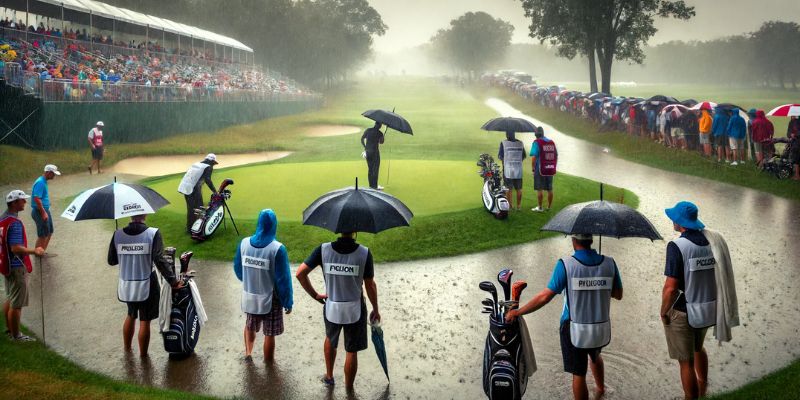The impact of weather on golf tournament outcomes can’t be overstated.
Weather plays a critical role in shaping not just the conditions of play but also the strategies that golfers choose to employ.
From gusty winds to torrential rains, understanding how weather influences the game is crucial for both players and organizers.
Weather Challenges at Open Events
Open golf tournaments are particularly susceptible to the impact of weather on golf tournament outcomes.
These events, often held on links courses, are exposed to the elements, where sudden changes in weather can dramatically alter the difficulty of a hole or the entire course.
High winds can redirect balls, rain can slow down greens, and even fog can cause delays and visibility issues that challenge even the most experienced players.
The unpredictability of weather requires players to adapt their strategies. They may need to choose different clubs, adjust their swing speeds, or change their approach to putting on wetter greens.
Spectators often see the true skill of players as they navigate these challenges, making dramatic weather conditions some of the most memorable moments in golf.
How Courses Prepare for Bad Weather
Course preparation is another critical aspect where the impact of weather on golf tournament outcomes is evident. Grounds crews work tirelessly to ensure that the course remains playable and safe.
This includes enhancing drainage systems to handle rain effectively, maintaining grass at optimal lengths to manage moisture, and using covers to protect certain areas of the course during harsh weather.
Advanced meteorological tools are also used by tournament organizers to predict weather changes accurately.
This allows for preemptive actions to be taken to minimize disruptions, ensuring that the schedule runs as smoothly as possible and reducing the risk of course damage.
Notable Weather-Affected Tournaments
Several tournaments throughout golf history have been significantly affected by weather.
For instance, the 1986 Open Championship at Turnberry was famously influenced by strong winds that changed competitive outcomes dramatically.
Another example is the 2012 AT&T National, where a derecho storm caused considerable damage, leading to rounds being played without spectators for safety reasons.
These events have left indelible marks on the sport, showing how integral and impactful weather can be.
They also highlight the resilience and adaptability of players and organizers, who continuously strive to deliver competitive and fair play under any circumstances.
Understanding the impact of weather on golf tournament outcomes is essential for appreciating the complexities and dynamic nature of golf.
Both players and organizers must continually adapt to these environmental challenges, which adds an unpredictable but thrilling element to the game.
How does rain affect golf play in tournaments?
Rain can slow down greens, make fairways softer, and increase the difficulty of bunkers, impacting both the strategy and execution of shots.
What equipment do golfers change when playing in windy conditions?
Golfers might opt for lower trajectory balls and heavier golf clubs to combat the effects of wind, ensuring greater control over their shots.
Can golf tournaments be postponed due to weather?
Yes, tournaments can be delayed or postponed if weather conditions are deemed unsafe for players or could severely impact the playability of the course.

